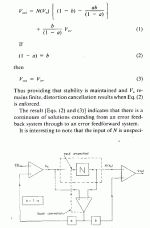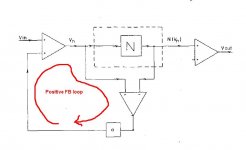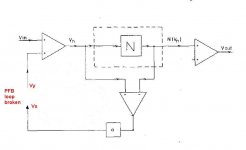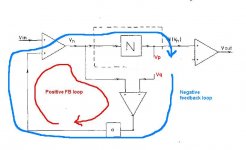Jan, see my post #571
It's an elementary goof in maths to simply cancel numerator and denominator when both have a value of zero. A feedback system is like an analogue computer and in order to resolve this indeterminant fraction it requires infinite gain and hunting.Consider the equations in Hawkford's paper. The eq(1) is always correct. But he then assumes an equality, b = (1-a), to simplify the eq(1) to make eq(3) Vout = Vin. This sets a trap for the circuit implementor! When b=0, (1-a)=0 and eq(1) then contains singularities:
traderbam said:Jan, see my post #571
It's an elementary goof in maths to simply cancel numerator and denominator when both have a value of zero. A feedback system is like an analogue computer and in order to resolve this indeterminant fraction it requires infinite gain and hunting.
OK thanks, I'll take a look at it. I agree that div by zero is a no-no, if that is actually the case.
Jan Didden
traderbam said:Hi Jan,
Good exercise for the brain, eh? 🙂
I think the ease of stability you mention is because in this case the overall gain from preceding stage to output is 1 or less, and the bandwidth is extended.
But within the EC circuit itself, I believe there is a barely tamed animal! Just like an op-amp in unity gain, non-inverting configuration. There is a huge amount of feedback due to the bootstrapping.
Try calculating the OL gain of the circuit by looking at the schematic. Disconnect the feedback signal from the output. What will the gain be? We know that the feedback factor is the ratio of OL to CL gain, so what does the feedback factor look like?
Another approach is to think about how the circuit can possibly correct an error without using feedback. What it attempts to do is to subtract input from output and feed it back into the input. But we know that for a non-linear function the subtractive error cannot possibly be the conjugate function needed to produce an error-free output. So the system has no choice but to "hunt" for an equilibrium solution.
Consider the equations in Hawkford's paper. The eq(1) is always correct. But he then assumes an equality, b = (1-a), to simplify the eq(1) to make eq(3) Vout = Vin. This sets a trap for the circuit implementor! When b=0, (1-a)=0 and eq(1) then contains singularities:
Vout = N(Vn) { 1 - 0/0 } + 0/0 Vin
In algebra, these tend to 1 "in the limit" (and is instantaneously equal to 1). Like magic. But the real circuit wasn't taught algebra at school so it must "hunt" for the equilibrium solution. If we are lucky it finds it rather than oscillates.
That's my theory, anyhow. 😉
Brian
Brian,
Yes I see your point. Let me see if i understand your reasoning:
Hawksford says there is a continium between pure error feedback and pure error feedforwad (and any combination thereof) depending on the ratio of a and b, where b=1-a. So, the solution b=0, a=1 is a legal solution, so it seems, and will result in pure error feedback. But, if you plug b=0 and a=1 into eq 1, you divide by zero and in mathematics that means 'undefined'. I don't think it is illegal, just that you can't say anything about the result. Maybe a math guru can comment on that.
Now, I don't really know what to do with that. My take on ec was to set b=0 and a=1, as shown in the attached diagram. The calculations don't seem to be problematic. If you calculate the fb factor, it comes out to (1/A)-1 where A is the OL gain. That why I say, if A>1, you have nfb; if A<1, it turns into pfb. If A=1, there's no fb. Automagically. So, I don't understand your reference to 'hunting' for a solution, unless you mean this auto-adjusting of the feedback.
One more thing: you say above "Disconnect the feedback from the output". But that's not how you disconnect the fb in this circuit. You need to look at the effective feedback. What you do is to disconnect one of the feedback paths and it is no wonder that you get funny things. If you want to disconnect the feedback, disconnect the output of the error summer to the input summer. And then, my friend, it's just a normal ol amp.
But I agree, good exercise for the mind. 😉
Jan Didden
Attachments
Hawksford revisited
Let me simplify Hawksford's diagram as we are talking about circuits where b=0 (there is no feed-forward).
I've marked the positive feedback loop. A positive feedback loop generates infinite gain. It is on this basis that Hawksford derives the two fundamental equations:
Vout = N{Vn}
Vn = Vin + a(Vn - N{Vn})
That second equation is not implementable in practice. It is like Zeus reached down from the heavens and said "let it be so".
Let me simplify Hawksford's diagram as we are talking about circuits where b=0 (there is no feed-forward).
I've marked the positive feedback loop. A positive feedback loop generates infinite gain. It is on this basis that Hawksford derives the two fundamental equations:
Vout = N{Vn}
Vn = Vin + a(Vn - N{Vn})
That second equation is not implementable in practice. It is like Zeus reached down from the heavens and said "let it be so".
Attachments
traderbam said:Jan, see my post #571
It's an elementary goof in maths to simply cancel numerator and denominator when both have a value of zero.....
You know better than that. Anytime a physical causal transfer is involved, it cannot possibly be real, meaning the substraction from a constant orders of magnitude closer to be real like a passive divider can never be null as a denominator.
Though you are right - and it is a valuable insight to expose the ties between NFB and EC - it is the kind of insight that does not open alternate design leads but all the contrary, reinforce the statu quo.
I should rather remain intrigued, looking for crazy different viewpoints with all the risks of colossal blunders, rather than shoehorning myself strictly to the beaten path.
Anyway, this very concept has been well beaten here so I will leave it for that.
Rodolfo
Re: Hawksford revisited
Brain,
I agree with almost all of it, except the last scentence. It IS implementable in practise. And again, I need to stress that you chose to arbitrarily single out one specific element of a multiloop feedback system. Yes, it is a pos fb loop that you have shown. But system behaviour is governed by the effective feedback that, in this case, consist of two loops, one as you have shown, and the other from the output. The feedback factor is (1/A)-1. Where is that infinite gain in the overall system transfer function, which is what counts?
You seem to feel that systems with pos fb are by definition unstable. Well, I have documented evidence of a guy (called Miller, by coincidence) who sold 1000-s of tube amps as long ago as 1953, with an inner pos fb loop and an outer nfb loop. Completely stable. Why? Because the effective feedback was nfb not too large to cause instability, but large enough to keep the total feedback negative. Bob's amp is stable. My amp is stable. My amp is VERY docile because the ol gain is just 22 overall.
Jan Didden
traderbam said:Let me simplify Hawksford's diagram as we are talking about circuits where b=0 (there is no feed-forward).
I've marked the positive feedback loop. A positive feedback loop generates infinite gain. It is on this basis that Hawksford derives the two fundamental equations:
Vout = N{Vn}
Vn = Vin + a(Vn - N{Vn})
That second equation is not implementable in practice. It is like Zeus reached down from the heavens and said "let it be so".
Brain,
I agree with almost all of it, except the last scentence. It IS implementable in practise. And again, I need to stress that you chose to arbitrarily single out one specific element of a multiloop feedback system. Yes, it is a pos fb loop that you have shown. But system behaviour is governed by the effective feedback that, in this case, consist of two loops, one as you have shown, and the other from the output. The feedback factor is (1/A)-1. Where is that infinite gain in the overall system transfer function, which is what counts?
You seem to feel that systems with pos fb are by definition unstable. Well, I have documented evidence of a guy (called Miller, by coincidence) who sold 1000-s of tube amps as long ago as 1953, with an inner pos fb loop and an outer nfb loop. Completely stable. Why? Because the effective feedback was nfb not too large to cause instability, but large enough to keep the total feedback negative. Bob's amp is stable. My amp is stable. My amp is VERY docile because the ol gain is just 22 overall.
Jan Didden
Ok, now let's remove Zeus from the equations and rewrite them as mere mortals.
In this diagram I have disabled the PFB loop by breaking its path. I want to examine what signals would be needed at Vx and Vy if we could achieve the condition where Vout = Vin.
Vout = Vin requires that:
Vy = F{Vout} - Vin, where F is the inverse function of N.
Let's see what the correction circuit provides at Vx:
Vx = a.(Vin + Vy) - a.Vout
The point is that Vx != Vy. This tells me that the circuit is not "cancelling" the output error. Instead, it hunts for an equilibrium. In Hawkford's equation the hunt is instantaneous. But we cannot implement this in practice.
In this diagram I have disabled the PFB loop by breaking its path. I want to examine what signals would be needed at Vx and Vy if we could achieve the condition where Vout = Vin.
Vout = Vin requires that:
Vy = F{Vout} - Vin, where F is the inverse function of N.
Let's see what the correction circuit provides at Vx:
Vx = a.(Vin + Vy) - a.Vout
The point is that Vx != Vy. This tells me that the circuit is not "cancelling" the output error. Instead, it hunts for an equilibrium. In Hawkford's equation the hunt is instantaneous. But we cannot implement this in practice.
Attachments
Jan wrote:
The general point I'm trying to make is that the "Hawkford EC" is no more capable of eliminating output error than a conventional NFB system BECAUSE it is no more than a feedback system. Hawksford's equations only eliminate error when there is infinite gain assumed, and any conventional NFB system will eliminate error too if it is granted inifinite gain.
No I didn't mean to say that. I agree with you that when you combine PFB and NFB loops you can make whatever you want. I was saying that the designer who is only familiar with NFB loops has to be careful when using PFB loops because they reduce stability and amplify distortion.You seem to feel that systems with pos fb are by definition unstable.
The general point I'm trying to make is that the "Hawkford EC" is no more capable of eliminating output error than a conventional NFB system BECAUSE it is no more than a feedback system. Hawksford's equations only eliminate error when there is infinite gain assumed, and any conventional NFB system will eliminate error too if it is granted inifinite gain.
Hey, give me a break! Of course Vx != Vy, you broke the loop! If it was, the loop wouldn't make any difference. If you do the same to any (neg) fb loop, you also get Vx!=Vy. That proves only that the loop does something.
And, again. You didn't break the pfb loop. You broke the effective feedback loop, which consists of the separate feedback paths, pos and neg.
Jan Didden
And, again. You didn't break the pfb loop. You broke the effective feedback loop, which consists of the separate feedback paths, pos and neg.
Jan Didden
traderbam said:Jan wrote:
No I didn't mean to say that. I agree with you that when you combine PFB and NFB loops you can make whatever you want. I was saying that the designer who is only familiar with NFB loops has to be careful when using PFB loops because they reduce stability and amplify distortion.
The general point I'm trying to make is that the "Hawkford EC" is no more capable of eliminating output error than a conventional NFB system BECAUSE it is no more than a feedback system. Hawksford's equations only eliminate error when there is infinite gain assumed, and any conventional NFB system will eliminate error too if it is granted inifinite gain.
Now we are getting somewhere. The infinite gain that classic nfb needs cannot be reached in practise, because it depends on real gain in the loop. Countless manyears have been spend the last millenium to try to maximize that gain toward infinity without becoming unstable. Sevaral rainforests have been cut to produce the paper to fight about this or that compensation scheme, only in the quest for infinite gain.
Lipschitz and Vanderkooy showed that even if that elusive infinite gain can be reached, you still cannot get *in theory* (let alone in practise) to zero distortion.
You say Hawksford ec is 'nothing more than a feedback system'. And you are right. But that's where all similarity ends. It does NOT depend on real infinite loop gain to get toward zero distortion. It does not 'assume' infinite gain either; you can't assume something that isn't there when you need it. And contrary to classic nfb, *in theory* (if not in practise) zero distortion IS possible.
Because that infinite gain is not needed, we at a stroke delete all compensation, stability and multi-stage gain tuning issues.
In my amp, the error summer is implemented with a current conveyor. That CC exhibits phase shift at higher frequencies, as any analog circuit would do. That means that the error correction signal starts to become the wrong polarity, like in a classic nfb system the fb signal starts to be of the wrong polarity because of the phase shift in Vout.
So, in my ec amp, I have to roll off the error correction signal for the same reason that you roll off the forward gain in a nfb system. But I don't have to roll off the forward gain, because that forward gain is just barely enough to sustain the cl gain.
We really need to think out of the box here.
Jan Didden
Jan wrote:
This is where we diagree. This may help make my case for me. Can you tell me what the NFB loop gain is: Vp/Vq?It does NOT depend on real infinite loop gain to get toward zero distortion.
Attachments
traderbam said:Jan wrote:
This is where we diagree. This may help make my case for me. Can you tell me what the NFB loop gain is: Vp/Vq?
Not from the top of my head. It's probably high.
Jan Didden
I work it out to be:
Vp = N{ -a.Vq / (1 - a) }
Erm, so when a = 1 (the "null" condition) the NFB loop gain is pretty big. Infinite.
Do you agree?
Vp = N{ -a.Vq / (1 - a) }
Erm, so when a = 1 (the "null" condition) the NFB loop gain is pretty big. Infinite.
Do you agree?
traderbam said:I work it out to be:
Vp = N{ -a.Vq / (1 - a) }
Erm, so when a = 1 (the "null" condition) the NFB loop gain is pretty big. Infinite.
Do you agree?
I had a hunch it would be big. But I don't know how to derive that. How do you get Vq which is an input terminal?
Jan Didden
PMA said:This reminds me disputations of Holy Inquisition .. 😀
At least we haven't beheaded anyone. Yet. 😀
Jan Didden
janneman said:.............
One more thing: you say above "Disconnect the feedback from the output". But that's not how you disconnect the fb in this circuit. You need to look at the effective feedback. What you do is to disconnect one of the feedback paths and it is no wonder that you get funny things. If you want to disconnect the feedback, disconnect the output of the error summer to the input summer. And then, my friend, it's just a normal ol amp.
.............
Hi Jan,
You still don't realize that you versus the rest of us are talking about two different things. You're talking about "effective feedback", whatever that may be according your opinion, and we're talking about the real FB loop gain (and phase). It's the latter that reveals what is really going on in an EC amp and it certainly does not look like just a "funny thing". Please forget your "effective feedback", it's totally misleading.
Cheers, Edmond.
Edmond Stuart said:
Hi Jan,
You still don't realize that you versus the rest of us are talking about two different things. You're talking about "effective feedback", whatever that may be according your opinion, and we're talking about the real FB loop gain (and phase). It's the latter that reveals what is really going on in an EC amp and it certainly does not look like just a "funny thing". Please forget your "effective feedback", it's totally misleading.
Cheers, Edmond.
Edmond,
I know that there is a pos fb loop. Just as there is a neg feedback loop. My point is that the system behaviour is governed by what ever the combined fb loops are. I have no problem if somebody breaks the combined feedback loop going into the input summer, and proofs whatever there is to prove.
For example, there are many opamp circuits with multiple feedback loops, like filters. The interaction of the various fb loops and the forward gain is what governs the system.
You and Brian are not talking about the real feedback loop gain, whatever THAT is. You conveniently break just a part of the combined loop and prove whatever there is to proof. If you want to break the loop, do it where it effects the system: where the combined fb signal is fed back into the input summer.
But if you just pick an arbitrary part of the combined loop, break that and then proof whatever, what value has that? What does it tell you about the system? You might as well break the pos loop and say, aha, see, this is just nfb. And then you have a very low fb value. But we know that already.
But this particular combination of pos and neg fb, called Hawksford EC, has some specific attributes. It merits more than a brush-off like, nah, its just pfb inside a loop.
I know the phenomen. Not Invented Here. But lets at least try to open our minds to alternatives to the tired old ways.
Jan Didden
- Home
- Amplifiers
- Solid State
- Bob Cordell Interview: Error Correction





